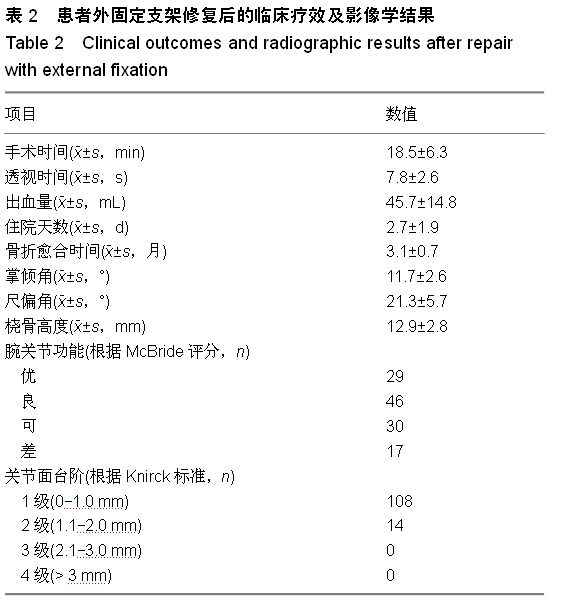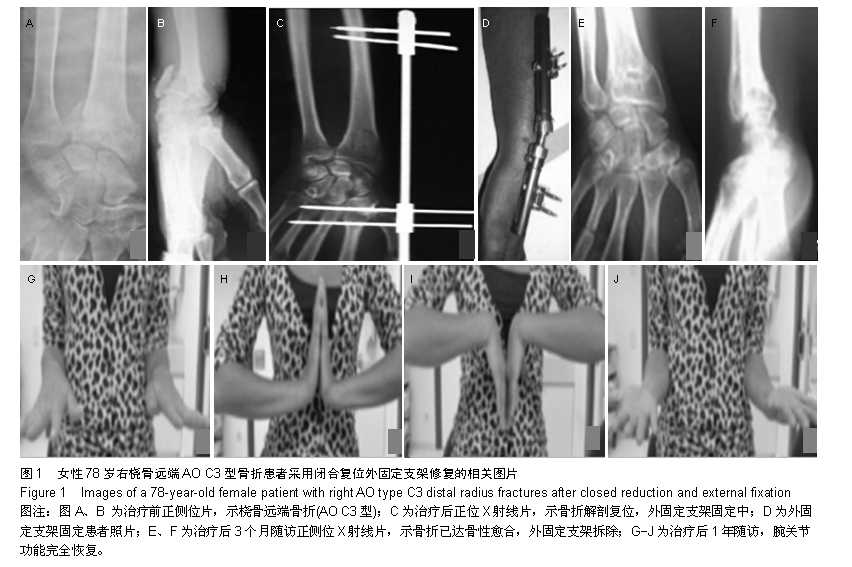| [1] Meisinger C, Wildner M, Stieber J, et al. Epidemiology of limb fractures. Orthopade. 2002; 31(1):92-99.
[2] Cummings SR, Melton LJ. Epidemiology and outcomes of osteoporotic fractures. Lancet. 2002; 359(9319): 1761-1767.
[3] Nguyen ND, Ahlborg HG, Center JR, et al. Residual lifetime risk of fractures in women and men. J Bone Miner Res. 2007; 22(6):781-788.
[4] Rachner TD, Khosla S, Hofbauer LC. Osteoporosis: now and the future. Lancet. 2011; 377(9773):1276-1287.
[5] Sambrook P, Cooper C. Osteoporosis. Lancet. 2006; 367 (9527): 2010-2018.
[6] Bartl C, Stengel D, Bruckner T, et al. The Treatment of Displaced Intra-articular Distal Radius Fractures in Elderly Patients. Dtsch Arztebl Int. 2014; 111(46):779-787.
[7] 金粉勤,薛锋,徐雪荣,等.外固定支架与钢板内固定治疗桡骨远端不稳定型骨折的疗效比较[J].中华创伤骨科杂志,2013,15(1): 87-89.
[8] Paksima N, Panchal A, Posner MA, et al. A meta-analysis of the literature on distal radius fractures: review of 615 articles. Bull Hosp Joint Dis. 2004; 62(1-2):40-46.
[9] Kawaguchi S, Sawada K, Nabeta Y, et al. Recurrent dorsal angulation of the distal radius fracture during dynamic external fixation. J Hand Surg Am. 1998; 23(5):920-925.
[10] Laulan J, Bismuth JP, Clément P, et al. An analytical classification of fractures of the distal radius: The "M.E.U." classification. Chir Main. 2007; 26(6):293-299.
[11] Cooney WP, Bussey R, Dobyns JH, et al. Difficult wrist fractures. Clin Orthop Relat Res. 1987; (214):136-147.
[12] Green DP, O’Brien ET. Open reduction of carpal dislocations: indications and operative techniques. J Hand Surg. 1978; 3(3): 250-265.
[13] Knirk JL, Jupiter JB. Intra-articular fractures of the distal end of the radius in young adults. J Bone Joint Surg Am. 1986; 68(5):647-659.
[14] Haus BM, Jupiter JB. Intra-articular fractures of the distal end of the radius in young adults: reexamined as evidence-based and outcomes medicine. J Bone Joint Surg Am. 2009; 91(12): 2984-2991.
[15] Porrino JA Jr, Maloney E, Scherer K, et al. Fracture of the distal radius: epidemiology and premanagement radiographic characterization. AJR Am J Roentgenol.2014; 203(3): 551-559.
[16] Kumbaraci M, Kucuk L, Karapinar L, et al. Retrospective comparison of external fixation versus volar locking plate in the treatment of unstable intra-articular distal radius fractures. Eur J Orthop Surg Traumatol. 2014; 24(2):173-178.
[17] 吕浩然,邹云雯,何二兴,等.两种方法治疗老年桡骨远端不稳定型骨折的疗效比较[J].中华创伤骨科杂志,2010,12(5):447-450.
[18] 邓迎生,张秋林,王秋根,等.掌侧锁定加压钢板与外固定支架治疗不稳定桡骨远端C型骨折的比较研究[J].中华创伤骨科杂志, 2007,9(10):935-939.
[19] 黄海晶,温建民.钢板内固定与小夹板治疗桡骨远端关节内骨折的效果比较[J].中国组织工程研究,2014,18(4):631-636.
[20] 郭勇,林旭,谭伦等.跨腕关节钢板与外固定支架治疗桡骨远端粉碎骨折的疗效比较[J].中华创伤骨科杂志,2011,13(8):704-709.
[21] 努尔哈那提•沙依兰别克,李忠伟,金格勒等.老年人桡骨远端骨折治疗后腕关节屈伸及旋转活动的Meta分析[J].中国组织工程研究,2014,18(17):2770-2776.
[22] Bartl C, Stengel D, Bruckner T, et al. Open reduction and internal fixation versus casting for highly comminuted and intra-articular fractures of the distal radius (ORCHID): protocol for a randomized clinical multi-center trial. Trials. 2011; 12:84.
[23] Grewal R, MacDermid JC, King GJ, et al. Open reduction internal fixation versus percutaneous pinning with external fixation of distal radius fractures: a prospective, randomized clinical trial. J Hand Surg Am. 2011; 36(12):1899-1906.
[24] Jeudy J, Steiger V, Boyer P, et al. Treatment of complex fractures of the distal radius: a prospective randomised comparison of external fixation 'versus' locked volar plating. Injury. 2012; 43(2):174-179.
[25] Moradi A, Ebrahimzadeh MH, Jupiter JB. Intra-articular fractures of the distal radius: bridging external fixation in slight flexion and ulnar deviation along articular surface instead of radial shaft. Tech Hand Up Extrem Surg. 2014; 18(1):41-50.
[26] 徐农,倪红联,李旱雨,等. 背侧入路微型锁定钢板内固定治疗桡骨远端背侧不稳定骨折[J].中华手外科杂志, 2015, 31(1): 21-23.
[27] 陈柯屹,杨广忠,马创,等.钢板内固定与外固定架治疗桡骨远端不稳定骨折的Meta分析[J].中国组织工程研究,2013,17(39): 6962-6969.
[28] Tarallo L, Mugnai R, Zambianchi F, et al. Volar plate fixation for the treatment of distal radius fractures: analysis of adverse events. J Orthop Trauma. 2013; 27(12):740-745.
[29] Rozental TD, Blazar PE. Functional outcome and complications after volar plating for dorsally displaced, unstable fractures of the distal radius. J Hand Surg Am. 2006; 31(3):359-365.
[30] Pichler W, Windisch G, Schaffler G, et al. Computer tomography aided 3D analysis of the distal dorsal radius surface and the effects on volar plate osteosynthesis. J Hand Surg Eur. 2009; 34(4):598-602.
[31] Casaletto JA, Machin D, Leung R, et al. Flexor pollicis longus tendon ruptures after palmar plate fixation of fractures of the distal radius. J Hand Surg Eur. 2009; 34(4):471-474.
[32] Drobetz H, Kutscha-Lissberg E. Osteosynthesis of distal radial fractures with a volar locking screw plate system. Int Orthop. 2003; 27(1):1-6.
[33] Figl M, Weninger P, Weninger P, et al. Unstable distal radius fractures in the elderly patient-volar fixed-angle plate osteosynthesis prevents secondary loss of reduction. J Trauma. 2010; 68(4):992-998.
[34] Chin KR, Jupiter JB. Wire-loop fixation of volar displaced osteochondral fractures of the distal radius. J Hand Surg Am. 1999; 24(3):525-533.
[35] Takami H, Takahashi S, Ando M. Comminuted intra-articular fracture of the distal radius with rotation of the palmar medial articular fragment: case reports. J Trauma. 1992; 32(3): 404-407.
[36] Harness NG, Jupiter JB, Orbay JL, et al. Loss of fixation of the volar lunate facet fragment in fractures of the distal part of the radius. J Bone Joint Surg Am. 2004; 86(9):1900-1908.
[37] Fernandez DL, Jakob RP, Buchler U. External fixation of the wrist. Current indications and technique. Ann Chir Gynaecol. 1983; 72(6):298-302.
[38] Bass RL, Blair WF, Hubbard PP. Results of combined internal and external fixation for the treatment of severe AO-C3 fractures of the distal radius. J Hand Surg. 1995; 20(3):373-381.
[39] Huch K, Hunerbein M, Meeder PJ. External fixation of intra-articular fracture of the distal radius in young and old adults. Arch Orthop Trauma Surg. 1996; 115(1):38-42.
[40] Geissler WB, Fernandez DL. Percutaneous and limited open reduction of the articular surface of the distal radius. J Orthop Trauma.1991; 5(3):255-264.
[41] Jakim I, Pieterse HS, Sweet MB. External fixation for intra-articular fractures of the distal radius. J Bone Joint Surg Br. 1991; 73(2):302-306.
[42] Chan BK, Leong LC, Low CO, et al. The use of the external fixator in the treatment of intra-articular fractures of the distal radius. Singapore Med J. 1999; 40(6):420-424.
[43] Cooney WP. External fixation of distal radial fractures. Clin Orthop Relat Res. 1983;(180):44-49.
[44] Goslings JC, Broekhuizen AH, Boxma H, et al. Three-dimensional dynamic external fixation of distal radial fractures. A prospective study. Injury. 1999; 30(6):421-430.
[45] Gausepohl T, Pennig D, Mader K. Principles of external fixation and supplementary techniques in distal radius fractures. Injury. 2000; 31(suppl 1):56-70.
[46] Hayes AJ, Duffy PJ, McQueen MM. Bridging and non-bridging external fixation in the treatment of unstable fractures of the distal radius: a retrospective study of 588 patients. Acta Orthopaedica. 2008; 79(4):540-547.
[47] Esposito J, Schemitsch EH, Saccone M, et al. External fixation versus open reduction with plate fixation for distal radius fractures: a metaanalysis of randomised controlled trials. Injury. 2013; 44(4):409-416.
[48] Walenkamp MM, Bentohami A, Beerekamp MS, et al. Functional outcome in patients with unstable distal radius fractures, volar locking plate versus external fixation: a meta-analysis. Strategies Trauma Limb Reconstr. 2013; 8(2):67-75.
[49] Xie X, Xie X, Qin H, et al. Comparison of internal and external fixation of distal radius fractures. Acta Orthopaedica. 2013; 84(3): 286-291.
[50] Wilcke MK, Abbaszadegan H, Adolphson PY. Wrist function recovers more rapidly after volar locked plating than after external fixation but the outcomes are similar after 1 year. Acta Orthopaedica. 2011; 82(1):76-81.
[51] Edwards GS Jr. Intra-articular fractures of the distal part of the radius treated with the small AO external fixator. J Bone Joint Surg Am. 1991; 73(8):1241-1250.
[52] Abramo A, Kopylov P, Geijer M, et al. Open reduction and internal fixation compared to closed reduction and external fixation in distal radial fractures: a randomized study of 50 patients. Acta Orthop. 2009; 80(4):478-485.
[53] Grewal R, Perey B, Wilmink M, et al. A randomized prospective study on the treatment of intra-articular distal radius fractures: open reduction and internal fixation with dorsal plating versus mini open reduction, percutaneous fixation, and external fixation. J Hand Surg. 2005; 30(4): 764-772.
[54] Xu GG, Chan SP, Puhaindran ME, et al. Prospective randomised study of intra-articular fractures of the distal radius: comparison between external fixation and plate fixation. Ann Acad Med Singapore. 2009; 38(7):600-606.
[55] Kreder HJ, Hanel DP, Agel J, et al. Indirect reduction and percutaneous fixation versus open reduction and internal fixation for displaced intra-articular fractures of the distal radius: a randomised, controlled trial. J Bone Joint Surg. 2005; 87(6):829-836.
[56] Leung F, Tu YK, Chew WY, et al. Comparison of external and percutaneous pin fixation with plate fixation for intra-articular distal radial fractures. A randomized study. J Bone Joint Surg Am. 2008; 90(1): 16-22.
[57] MacDermid JC, Turgeon T, Richards RS, et al. Patient rating of wrist pain and disability: a reliable and valid measurement tool. J Orthop Trauma. 1998; 12(8):577-586.
[58] Imaeda T, Uchiyama S, Wada T, et al. Reliability, validity, and responsiveness of the Japanese version of the Patient-Rated Wrist Evaluation. J Orthop Sci. 2010; 15(4):509-517.
[59] Phadnis J, Trompeter A, Gallagher K, et al. Mid-term functional outcome after the internal fixation of distal radius fractures. J Orthop Surg Res. 2012;7:4.
[60] 杨召,马信龙,马剑雄,等. 动态外固定架与静态外固定架治疗不稳定桡骨远端骨折远期疗效的Meta分析[J].中国矫形外科杂志, 2014,22(10):880-885. |


.jpg)